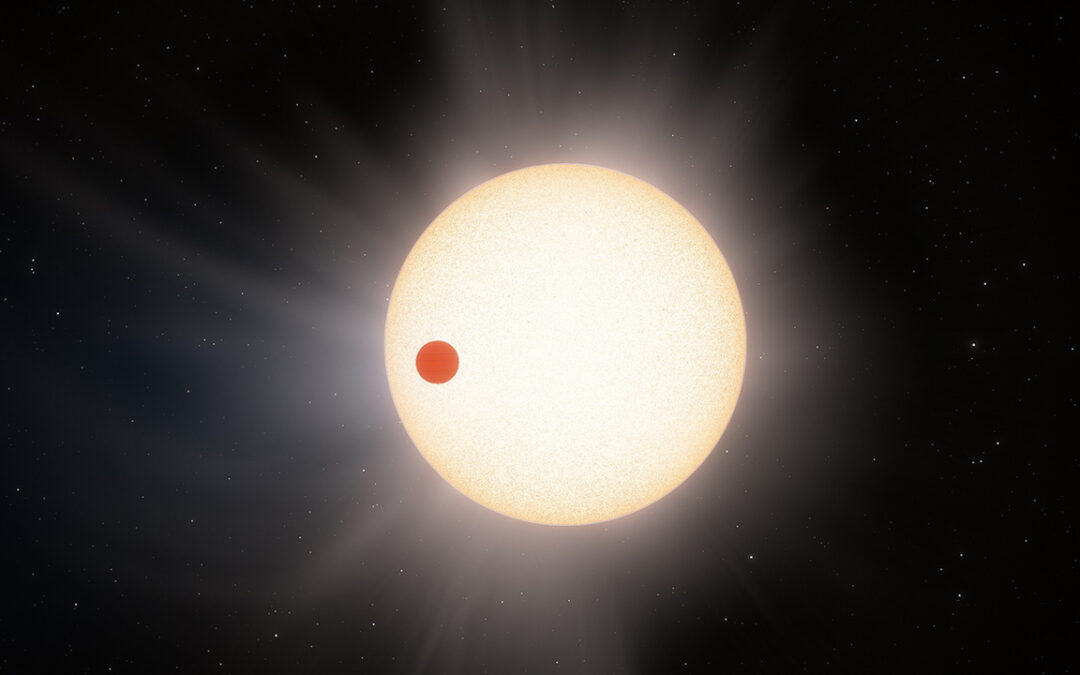We have been examining extrasolar planets – planets that orbit a star other than the sun. The first exoplanets were discovered by measuring the slight wobble their gravity induces on their star. Amazingly, and despite the challenges involved, around 50 exoplanets have now been directly observed using powerful telescopes. But the majority of exoplanets have been discovered using the transit method. This technique, along with the others, has allowed us to discover nearly 5000 extrasolar planets.
The Transit Method
Since stars are extremely distant, current technology does not allow us to see any details on their surface, or even to resolve a disk (to see noticeable size) for any but the very largest stars.[1] That is, most stars appear point-like in even the largest telescopes. Although we cannot see details, we can measure the overall brightness of the star with extremely high precision and accuracy. If a star were to change brightness (for whatever reason) by even one percent, we could detect this change with modern instrumentation. This opens up an innovative way to detect an extrasolar planet.
If a star system happens to be nearly edge-on as seen from Earth, then its planets will occasionally cross directly in front of their star, essentially casting their shadow on Earth. Although we cannot resolve the star, we can measure a slight drop in its total brightness as the planet passes in front of it. This event is called a transit.

The transit method of detecting extrasolar planets requires not only high-precision photometry (measuring the brightness of the star over time), but also careful reasoning. This is because there are several mechanisms by which a star can dim or brighten over time that have nothing to do with planets. Some stars pulsate; they change their size over time. This is accompanied by a change in brightness as well. Some of these stars pulsate with a very regular frequency. For example, rr Lyrae stars pulsate with a period of a few hours to a couple of days – depending on the star. Cepheid variable stars pulsate with a period of several days, whereas Mira variable stars have a period in excess of 100 days. Some other stars pulsate in a way that is not regular or predictable.
By tracking the brightness of a star over time, we can plot the star’s brightness as a function of time – a light curve. Rapidly pulsating stars like rr Lyrae stars and Cepheid variables have very recognizable light curves. Some stars pulsate in a way that is not so smooth or regular. And there are other phenomena that can affect a light curve such as flares or starspots. A flare would cause a sudden increase in the brightness of a star. A starspot (like a sunspot but on a star) is a dark region on the star’s luminous surface. Starspots rotate along with the star and therefore have a fairly regular period.[2]
A transiting planet will cause a temporary dip in the star’s light curve. But we must carefully distinguish this from other dips caused by starspots or pulsations. Fortunately, these three distinct phenomena produce very different types of dips in the light curve. A dip due to a regular pulsation tends to be very smooth and regular. A dip caused by a starspot will have approximately the same period as the rotation period of the star. Furthermore, a starspot will be on the earth-facing side of the star roughly fifty percent of the time. Therefore, the dip in the light curve will be present in roughly 50% of the light curve and will have a sinusoidal shape due to foreshortening of the spot when it is near the limb.
Likewise, a transiting planet would produce a very specific type of dip in a star’s light curve. This dip would have a nearly rectangular shape: a sudden dip in brightness which remains nearly constant until the transit is complete followed by a sudden return to normal brightness.[3] This is the characteristic shape we would expect to see of an object passing directly in front of the star. Of course, for this object to be a planet, it must orbit its star. Therefore, if we monitor the star’s brightness for a long period of time, we should see additional dips in the light curve at extremely regular intervals. The interval between dips is the period of the orbiting planet. We would need to see at least three such equidistant dips to know for certain that we are seeing the transit of an orbiting planet.
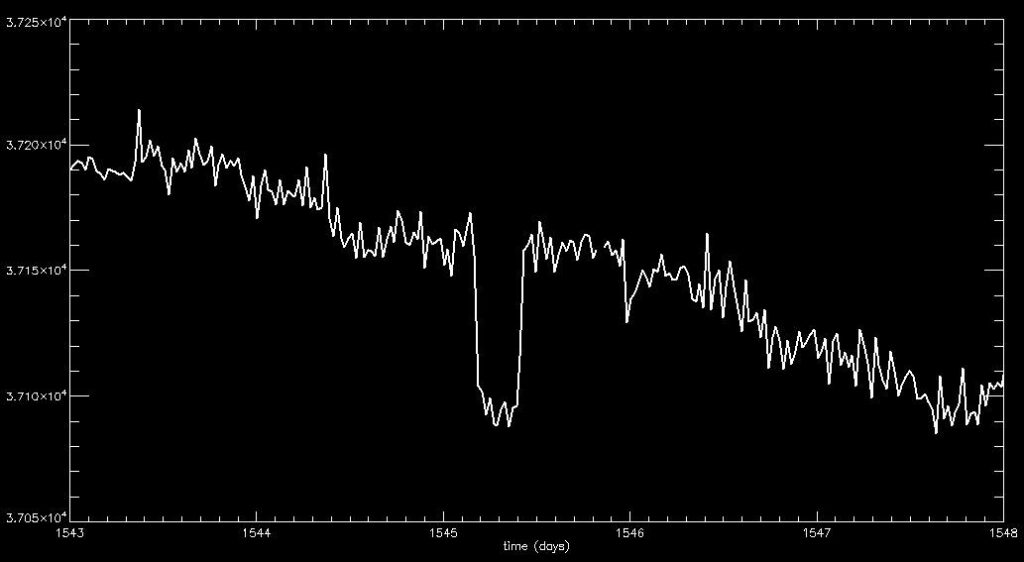
Drawbacks and Benefits of the Transit Method
The main disadvantage of the transit method is that it only works for stellar systems that are nearly edge-on relative to us. If the system is tilted only a few degrees from edge-on, then the orbiting planets will pass above or below their star as see from Earth, and will not produce a transit. The good news is that there are at least 100 billion stars in our galaxy. So, if only 1 in 1000 is edge-on relative to us, this leaves one hundred million star systems that are edge-on. If any such system has planets, they will eventually transit their star.
The other disadvantage of the transit method is that it requires us to monitor the brightness of a star for a long period of time. After all, planets only transit their star once per orbit. Therefore, long-period planets require long-period observations. The transit method, like the Doppler shift method, is therefore most sensitive to the discovery of short-period planets that orbit close to their star. Furthermore, since short-period planets orbit close to their star, they can transit over a greater range of orbital inclinations. In other words, they don’t have to be exactly edge-on, but can be off by several degrees and still transit. The orbits of outer planets would have to be within a fraction of a degree of edge-on to transit.
However, the transit method has several advantages as well. Unlike the Doppler shift method, the transit method does not require taking spectra of stars at multiple times, which can be time-consuming. Photometry is very straightforward, and therefore the exact brightness of thousands of stars can be tracked over time with modern technology. The Kepler spacecraft does exactly that. Unlike the direct imaging method, the transit method does not require that the stars are nearby or clearly resolved. So, this method has tremendous range. For these reasons, many planets have been detected by the transit method.
Additionally, the transit method provides information about the planet that is difficult or impossible to obtain by other methods. For example, it allows us to estimate the size of the planet. After all, the fraction of the star’s light that is blocked by the planet will be proportional to the cross-sectional area of the planet. This area is simply the square of the radius of the planet multiplied by pi. The size of the star can be estimated by its spectrum, and the planet’s size is then computed by the percentage of light blocked during transit.
Recall that the Doppler shift method does not provide any information on the size of the planet, but it does provide an estimate of the minimum mass of the planet. The reason why only the minimum mass can be known is because the orientation of the system is unknown; it could be nearly edge-on, or nearly face-on. But a planet discovered by the transmit method must orbit its star nearly edge-on. Therefore, if we follow up on a transiting system by measuring the star’s wobble using the Doppler shift method, we can discover the mass of the planet. This is not just the minimum mass, but the actual mass since we know the orientation of the system – edge-on.
Knowing the actual mass of the planet along with its size allows us to compute the planet’s density. This gives us some idea of the planet’s composition. Rocky planets like Venus and Earth tend to have a density of around 3 to 5 grams per cubic centimeter. However, gas giants like Jupiter and Saturn have a density between 1 and 1.5 grams per cubic centimeter. Therefore, when the transit method is combined with the Doppler method, we can actually know what kind of planet we have discovered. Scientifically, this is even better than direct imaging.[4]
Strange New Worlds
The first observed transit of an exoplanet occurred in September 1999 across the star HD 209456. The planet HD 209456 b had already been discovered by the Doppler shift method. But the orientation of the system was unknown. On the chance that the system might be edge-on, astronomers searched for the expected dip in the star’s light curve as the planet passed by the star. Sure enough, a 1.7% drop in brightness occurred for about three hours at the expected time. This indicated that indeed the system was nearly edge-on relative to Earth. It also allowed the size of the planet to be measured, along with its true mass and thus its density. This was the first exoplanet for which such determinations were possible.
HD 209456 b orbits remarkably close to its star at a distance of only 0.04747 AU, about eight times closer than Mercury is to the sun, with an orbital period of only 3.52 days. The planet is about 70% the mass of Jupiter (220 Earths), and is 35% larger than Jupiter. It is therefore unquestionably a gas giant, and has been given the informal name “Osiris.” Before this discovery, some astronomers had speculated that “hot Jupiters” were actually giant rocky worlds, since gas giants cannot form so close to their star in the standard secular model. But the transit method combined with the Doppler shift method allows us to know that the actual density of the planet is less than that of Jupiter, meaning the planet is indeed a gas giant.
Since Osiris orbits so close to its star, it has an estimated temperature of around 1300 degrees Fahrenheit. Such a hot temperature causes the planet to glow in the infrared part of the spectrum. In fact, the infrared radiation of the planet has been detected by the Spitzer Space Telescope. Although dwarfed by the infrared radiation from the star itself, Spitzer detected a slight drop in the total intensity as the planet passed behind the star.
The first planet to be discovered by the transit method is OGLE-TR-56 b.[5] It too is a hot Jupiter, orbiting its star at a distance of only 0.0225 AU and with a period of only 29 hours. The existence of this planet was also confirmed using the Doppler shift method, which allowed astronomers to determine the mass of the planet at 1.29 times the mass of Jupiter.
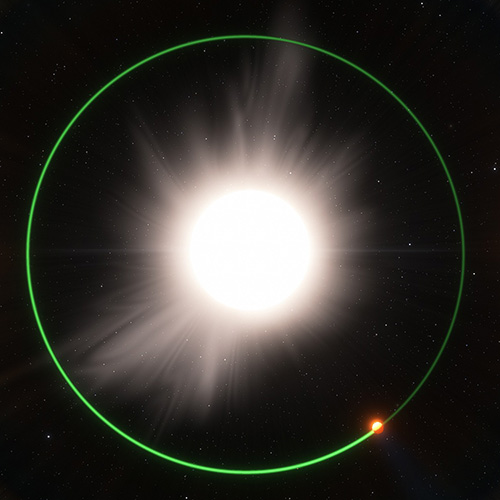
Thousands of extrasolar planets were discovered in data collected by the Kepler spacecraft. This craft was launched in 2009, and continually monitored the brightness of hundreds of thousands of stars for a period of over nine years. The first planets discovered in Kepler data were hot Jupiters. These are the easiest types of planets to discover by the transit method because their short period produces lots of transits, and the large size of these planets produces relatively large dips in the light curve.
In 2011, the first rocky exoplanet was discovered using Kepler data. Kepler 10 b is 1.4 times the diameter of Earth, and about 4.5 times Earth’s mass. Thus, the high density (8.8 grams per cubic centimeter) means this cannot be a gas giant, but is a solid world – a “super Earth.” The planet orbits 20 times closer to its star than Mercury is from the sun, resulting in estimated daytime temperatures in excess of 2,500 degrees Fahrenheit. The star is about 560 light years away from us.
Also in 2011 was the first discovery of an exoplanet orbiting two stars. The two stars orbit their common center of mass every 41 days. And since their orbital plane is nearly edge-on relative to us, these stars eclipse each other twice every orbit – an example of an eclipsing binary. The planet Kepler-16b orbits at a greater distance with a period of 229 days. It is a Saturn-sized gas giant, one third the mass of Jupiter, but orbiting at about the distance that Venus orbits the sun.
The Kepler-90 system is also of particular interest because it currently has eight known planets – just like our solar system.[6] The eighth planet, Kepler-90 i, was discovered in 2017. All eight orbit closer to their star than Earth is to the sun, like a miniature version of our solar system. The inner six planets are each between 1.1 and 2.9 times the diameter of the Earth. The outer two are gas giants, 8.1, and 11.3 times the diameter of Earth respectively. Curiously, the inner one (with 8.1 Earth diameters), Kepler-90 g, has a mass only 15 times that of Earth, which makes its density only 0.15 grams per cubit centimeter. It must be a very “puffy” planet, and astronomers have begun referring to such low-density planets as “super-puffs.” As astronomers Piro and Vissapragada state, “Planets with such extended atmospheres are challenging for current evolutionary models, since they should be susceptible to photoevaporation.”[7] That is, their atmosphere should leak away over millions of years. Of course, it is not a problem for the biblical timescale. The eight planets in this system are all in a near orbital resonance, meaning the ratio of any two orbital periods is close to a simple fraction, like 2/3, or 7/11. This is a very stable configuration.
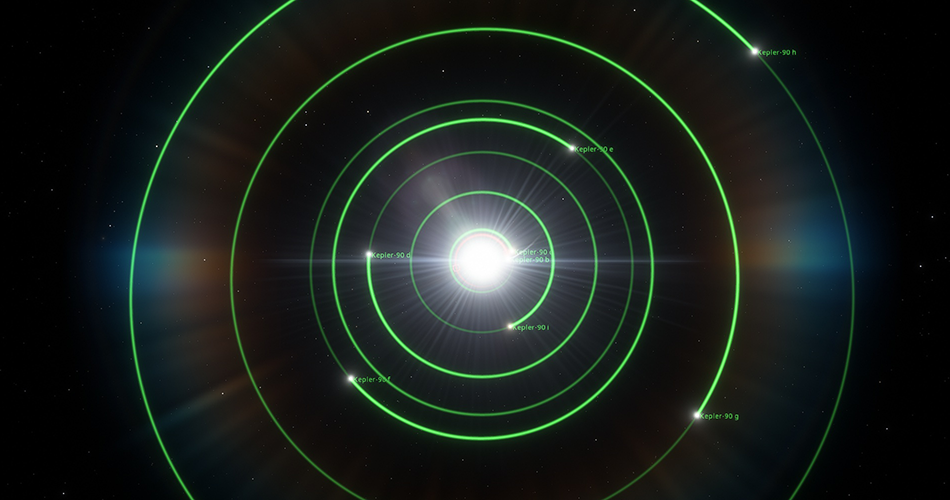
In our own solar system, four of the eight planets have a system of rings – trillions of tiny moonlets orbiting around the planet’s equator. However, only Saturn’s rings are thick enough to be seen easily from Earth-based telescopes. If a planet had rings as thick as Saturn’s, and if these rings were tilted relative to our solar system, then they might be detectable as the planet transits a star. The shape of the dip in the light curve would be slightly different from that of a planet with no rings. Since one out of eight planets in our own solar system has thick rings, astronomers had expected to find evidence of rings on many exoplanets as well. However, thick rings are apparently much rarer than previously thought. To date, only one transiting exoplanet has compelling evidence of rings.[8]
One early candidate for a massive ring system on an exoplanet was proposed for the star PDS 110. This star showed two apparent transit events separated by 808 days. The dimming was consistent with a massive rings system surrounding the transiting planet. However, follow-up observations showed that the next predicted transit failed to occur, which calls into question an orbiting planet at all, let alone a planet with massive rings.[9] The exact mechanism of the non-periodic dimming is currently unknown.
However, there is evidence that a planet orbiting the star J1407 has a massive ring system that is over 600 times the diameter of the rings of Saturn. The system of rings was discovered during an apparent transit event in April and May, 2007. By mapping the multiple dips in the light curve and their relative intensity, astronomers found that the ring system has at least 37 distinct rings. Since only one transit has been observed, we do not know the orbital period of the planet, but it is estimated to be on the order of decades. Hopefully a second transit in the next several years will confirm this discovery. Interestingly, in our own solar system, the rings of Uranus were discovered as they transited a distant background star.
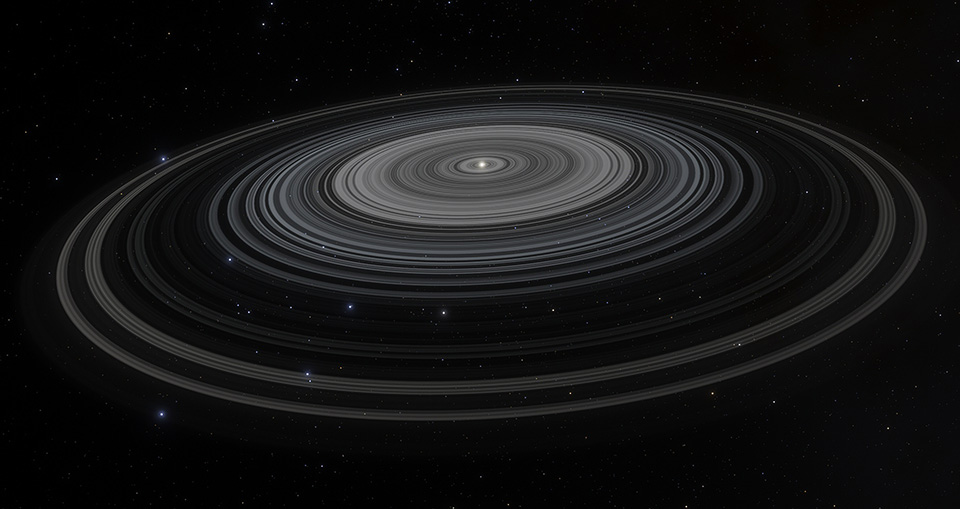
The dips in the light curve of J1407 indicate gaps and divisions in the rings, like the Cassini Division in Saturn’s rings. Such gaps imply the existence of unseen moons.[10] In fact, in other star systems, there are currently six possible detections of exomoons – moons orbiting an extrasolar planet. However, none have been definitively confirmed as these are at the extreme limits of current technology.
When spectroscopy is applied to transiting extrasolar planets, astronomers are able to glean additional information regarding these worlds. This has led to some surprising results that challenge secular formation scenarios, but are consistent with biblical creation. More to come.
[1] Betelgeuse is one exception. It is a red supergiant and one of the nearest ones. Using the most powerful telescopes along with mathematical methods, astronomers have been able to resolve the disk of this star – but just barely. Some of the larger surface features of Betelgeuse have also been directly observed.
[2] We know that sunspots on the sun are carried along with its rotation. However, they can also drift a bit on their own. Therefore, the rotation period of a sunspot is not exactly regular, but it is very close to the sun’s rotation period at the latitude of the spot. There is evidence that some stars also have spots on their surface that likewise drift but are primarily carried along by the star’s rotation.
[3] This is an approximation. If the temporal resolution of the light curve is sufficiently high, we may notice that the onset of the transit is not quite instantaneous, and thus the sides of the dip are not perfectly vertical. This is because at the start and end of the transit, there is a brief period where the planet is only partially transiting the star – where only part of the planet’s disk is blocking starlight. Furthermore, the bottom of the dip will not be perfectly horizontal, but slightly sagging due to limb darkening. That is, most stars (like the sun) appear brightest in the center, and fainter near the limb. Hence, a planet blocks the most luminous part of the star near the middle of the transit, resulting in the deepest part of the dip.
[4] It is possible to estimate the size of the planet from direct imaging in some cases even though the planet is never resolved with current technology. The size can be estimated from the brightness of the planet if we knew the reflectivity (the albedo) of the planet. The albedo can be estimated by comparing images in visible light to those in the infrared part of the spectrum. However, this size estimate is not as precise as that obtained from the transit method.
[5] The OGLE project (Optical Gravitational Lensing Experiment) was originally developed to detect massive compact halo objects as they pass in front of a background star, temporarily increasing the star’s apparent brightness due to gravitational lensing.
[6] Sorry Pluto. ☹
[7] https://arxiv.org/abs/1911.09673v1
[8] This does not include the possible massive ring system around Fomalhaut b, since it is not a transiting planet.

